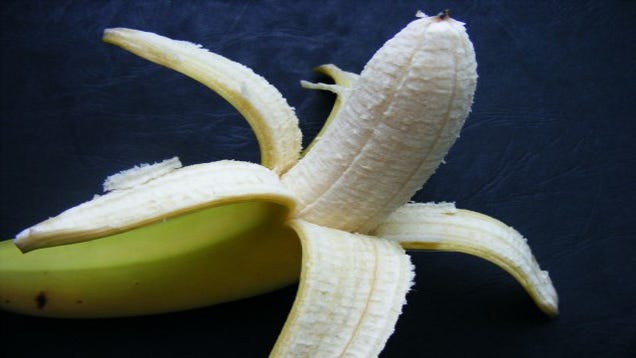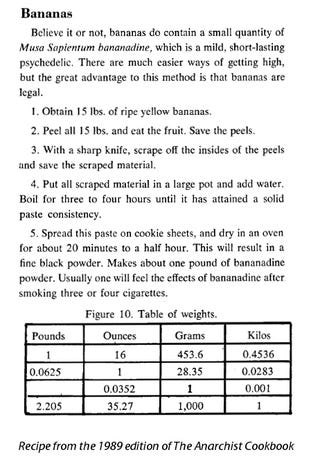
Every hear of (or see) someone smoking a banana peel to get high? Neither have I. However, the smoking of banana peels has a history dating to the late 1960s in the United States and Canada, with smokers allegedly receiving a hallucinogenic trip.
Where did this phenomenon start, and are there any hallucinogens tucked away in a typical banana?
Spreading the banana gospel
In the late 1960s, stories of the hallucinogens hidden in local grocery stores and fruit stands spread through North America. According to these tales, separating, boiling, baking, and drying bananas would allow a user to extract the chemical bananadine and enter into a potent psychedelic experience.
In 1967, Country Joe McDonald, lead singer of Country Joe & the Fish, found a large banana previously used as part of decoration of a parade float. The band strapped the banana to a car and drove around the Haight-Ashbury neighborhood of San Francisco to promote their band.
During this afternoon, the band announced from a bull horn that smoking banana peels would induce a hallucinogenic response. Country Joe & the Fish also passed out banana peel joints to audience members at concerts.
Later in 1967, the Berkeley Barb, a counterculture newspaper published a recipe for turning a batch of bananas into powerful hallucinogen, initiating the spread of the banana gospel. The Berkeley Barb did not use the term bananadine in the article, a fictional chemical later believed to be responsible for hallucinogenic effects accompanying the smoking of banana peels.
A ghastly and difficult recipe
The combination of underground word of mouth and a desire for a cheap and easy to acquire hallucinogen led to the proliferation of rumors supporting the smoking of banana peels. At least one New York area banana seller offered rebates to each customer who returned their banana peel.
Various recipes for preparing banana peels spread across the United States and Canada, with the process detailed in William Powell's The Anarchist Cookbook. Powell included the recipe in the "Drugs" section alongside procedures for purifying and using LSD, psilocybin, and peyote. The inclusion of an odd recipe for a banana peel extract next to these hallucinogens lent a sense of credibility to the practice. Over time, enthusiasts lent the fake chemical name bananadine to the extract, with bananadine annotated within the scientific name for a type of banana The Anarchist Cookbook.
Recipes for creating a hallucinogen using bananas are often comical, if only from the perspective of their difficulty level. The recipe does not make use of the yellow exterior of bananas, but the white mushy part lining the interior of the peels. Most recipes, including the one published in The Anarchist Cookbook, require fifteen to twenty pounds of bananas and several days to create a single batch of bananadine extract.
In later recipes, alcohol and the chemical use dichloromethane (a carcinogen often used to strip paint) are used in order to obtain crystals of bananadine. One could easily get a buzz by combining alcohol and dichloromethane — when those two chemicals are included in the recipe, the bananas are no longer necessary.

Government response and current recipes
The alleged hallucinogenic possibilities of prepared banana peels raised the eye of the Food and Drug Administration. Researchers at NYU determining that banana peels contain nothing out of the normal – the only high associated with smoking the fruit is a placebo effect, with the FDA concurring. Additionally, the chemical "bananadine" has not been discovered or isolated. These research findings failed to stop the bananadine craze, with counterculture enthusiasts dismissing the reports as a government constructed conspiracy.
Current variations of the recipe include notes for speeding up the process including microwaving the bananas. Annotations state this is a safe practice as bananadine is not "microwave soluble" — a type of solubility I never came across in graduate school. Another recipe touts that the addition of crushed peanut shells to the the banana extract makes it orally active, removing the need to smoke your final product.
Banana extracts are still sold and peels are smoked by those looking for an available high and gullible enough to satisfy themselves via placebo effect. Banana peel extract does have (at least) one positive use — it decreased the enlargement of prostate glands in mice according to a 2009 study.
Top image by Emillian Robert Vicol/Public Domain Photos/Flickr. Additional images from the 1989 edition of the Anarchist Cookbook and the Dodd Center. Sources linked within the article.
Nenhum comentário:
Postar um comentário
Observação: somente um membro deste blog pode postar um comentário.